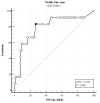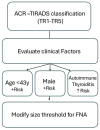Integrating Clinical Parameters into Thyroid Nodule Malignancy Risk: A Retrospective Evaluation Based on ACR TI-RADS
- PMID: 40806974
- PMCID: PMC12347102
- DOI: 10.3390/jcm14155352
Integrating Clinical Parameters into Thyroid Nodule Malignancy Risk: A Retrospective Evaluation Based on ACR TI-RADS
Abstract
Background/Objectives: Thyroid nodules are commonly found through sensitive imaging methods like ultrasonography. While most nodules are benign and asymptomatic, certain characteristics may indicate malignancy, prompting fine needle aspiration biopsy. Factors like age and gender affect cancer risk, complicating ultrasound-based risk systems. We aimed to determine whether the cytological malignancy rate of thyroid nodules could be adjusted for several clinical parameters. Methods: Data from patients aged 18 and above with thyroid nodules assessed via fine needle aspiration (FNA) were retrospectively reviewed. Malignancy classification was based on cytopathology and histopathology results. The study examined how various clinical parameters, adjusted for the ACR TI-RADS category, affected thyroid nodule malignancy rates, including age, sex, Body Mass Index (BMI), nodule size, presence of autoimmunity, and thyroxine therapy. Additionally, we analyzed the performance of ACR TI-RADS in predicting malignant cytology across different age subgroups of thyroid nodules. Results: The study included 1128 thyroid nodules from 1001 adult patients, with a median age of 48 years and predominantly female (76.68%). Malignancy rates varied across ACR TI-RADS categories, with higher rates associated with larger nodules and younger age groups. Age emerged as a significant predictor of malignancy, with a consistent decrease in the odds ratio for malignant cytology with advancing age across all ACR TI-RADS categories, indicating its potential utility in risk assessment alongside nodule size and sex. Conclusions: Raising the size threshold for recommending FNA of TR3-3 nodules and incorporating patients' age and gender into the evaluation process could enhance the system's accuracy in assessing thyroid nodules and guiding clinical management decisions.
Keywords: Thyroid Imaging Reporting and Data System; age; malignancy; thyroid nodules.
Conflict of interest statement
The authors declare no conflicts of interest.
Figures




Similar articles
-
Efficacy Assessment and Influencing Factors on Superb Microvascular Imaging (SMI) Microflow Patterns in Solid Thyroid Nodules: What Matters?Ultrasound Med Biol. 2025 Sep;51(9):1389-1398. doi: 10.1016/j.ultrasmedbio.2025.04.002. Epub 2025 Jun 14. Ultrasound Med Biol. 2025. PMID: 40518320
-
A Practical CEUS TI-RADS Refer to Score and Grading of ACR TI-RADS (2017) for Thyroid Nodules.Ultrasound Med Biol. 2025 Aug;51(8):1352-1360. doi: 10.1016/j.ultrasmedbio.2025.05.005. Epub 2025 May 24. Ultrasound Med Biol. 2025. PMID: 40414781
-
Assessing the Diagnostic Accuracy of TI-RADS in Pediatric Thyroid Nodules: A Multi-institutional Review.J Pediatr Surg. 2025 Jan;60(1):161924. doi: 10.1016/j.jpedsurg.2024.161924. Epub 2024 Sep 13. J Pediatr Surg. 2025. PMID: 39358076
-
Diagnostic Performance of Six Ultrasound Risk Stratification Systems for Thyroid Nodules: A Systematic Review and Network Meta-Analysis.AJR Am J Roentgenol. 2023 Jun;220(6):791-803. doi: 10.2214/AJR.22.28556. Epub 2023 Feb 8. AJR Am J Roentgenol. 2023. PMID: 36752367
-
Levothyroxine or minimally invasive therapies for benign thyroid nodules.Cochrane Database Syst Rev. 2014 Jun 18;2014(6):CD004098. doi: 10.1002/14651858.CD004098.pub2. Cochrane Database Syst Rev. 2014. PMID: 24941398 Free PMC article.
References
-
- Kwong N., Medici M., Angell T.E., Liu X., Marqusee E., Cibas E.S., Krane J.F., Barletta J.A., Kim M.I., Larsen P.R., et al. The Influence of Patient Age on Thyroid Nodule Formation, Multinodularity, and Thyroid Cancer Risk. J. Clin. Endocrinol. Metab. 2015;100:4434–4440. doi: 10.1210/jc.2015-3100. - DOI - PMC - PubMed
-
- Angell T.E., Maurer R., Wang Z., Kim M.I., Alexander C.A., Barletta J.A., Benson C.B., Cibas E.S., Cho N.L., Doherty G.M., et al. A Cohort Analysis of Clinical and Ultrasound Variables Predicting Cancer Risk in 20,001 Consecutive Thyroid Nodules. J. Clin. Endocrinol. Metab. 2019;104:5665–5672. doi: 10.1210/jc.2019-00664. - DOI - PubMed
LinkOut - more resources
Full Text Sources

